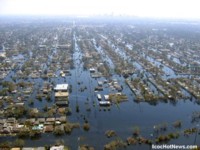Rebuilding Cities In A Climate-Damaged World

“There’s no
alternative to sustainable development.”
by Marc
Stoiber
September
8, 2010 - So began
target=”_blank”>a 2009 article in Harvard Business Review.
Although the message was aimed at business, it applies equally well
to building cities.
This is
especially prescient when the cities in question were damaged or
destroyed by climate disaster. Are they being redeveloped with an
eye to accommodating that climate, and lessening its
impact?
If we use
Pakistan as an example, the answer seems to be ‘no’.
Pakistan is
currently experiencing the
target=”_blank”>worst floods in 80 years. 1,600 are dead, and
more than 20 million affected - nearly 10% of the population.
It’s too early to
say if rebuilders will incorporate systems that help Pakistan’s
cities accommodate flooding this time. Past experience doesn’t
paint a promising picture. There are
target=”_blank”>regular floods in the country, and each one
seems to surpass the last in damage caused. Clearly, rebuilding
efforts have not addressed the recurring flood problem, leading to
ever-more-expensive repetition.
Here in North
America, the
target=”_blank”>damage caused by Hurricane Katrina echoes that
of Pakistan. 1,836 people died, 15 million people were affected,
275,000 homes were lost.
Unlike Pakistan,
however, the US Army Corps of Engineers is building a
target=”_blank”>$14.3 billion line of defense. This will
provide greater safety against storms. But it’s a system designed
solely for protection, and not accommodation.
rethink
Tragedies like
these create opportunities to start anew, with modern approaches
and the lens of a more sustainable future.
Core to this is
an approach that transitions from immediate needs to insightful
long-term strategies.
From technology
and systems thinking to urban design and economic development, the
community needs to consider not just rebuilding, but reassessing
the way the city interacts with nature.
The long term
vision has to incorporate restoration of natural harmony, not just
damage control. This means constructing cities that blend
environmental value with value to humans.
anatomy
The city is, in
many ways, similar to the human body: a dynamic, complex system
that influences, and is influenced by, its environment.
The norm in urban
planning can be likened to the ‘isolated ailment’ thinking of
traditional western medicine. Heart treatments, for example,
generally focused on the heart - not the stressful, unhealthy
existence of the person.
Holistic cures,
thankfully, are considering ailments on a broader level. Today,
patients can be target=”_blank”>treated for cancer, for example, even as they
undergo vitamin and diet treatment to boost their internal
well-being, and spiritual and physical programs to make them less
susceptible to stress and disease.
Imagine if
Pakistan and the Gulf Coast took the same approach?
The biggest
hurdles preventing a holistic approach to rebuilding
climate-damaged cities are timelines, silo thinking, and
scale.
Governments
generally function on a three-year timeline. As such, it is rare to
find an administration willing to risk taxpayer money in a program
with a distant payback. Short-term fixes that return life to status
quo are far more popular.
Even if there is
vision for creating a more sustainable city, silos between local
authorities, planners, developers and NGOs can hamper
implementation. If the city was struck by a climate disaster, the
silo problem only increases, as relief agencies and the military
are added to the mix.
Finally, there is
the problem of scale. Revisiting the comparison with the human
body, it is no easy matter to heal multiple systems that interact
on many different levels - especially if the treatment has to
happen rapidly to avoid even greater damage.
innovators
- Address the
deeper cause of damage - Cities damaged by climate disaster must
look at the deeper causes of that disaster. Hurricanes happen, but
hurricanes that wipe out cities can be mitigated if natural
barriers are left intact. - Get outside the
jar - There are many experts in the field of urban planning and
implementation. Unfortunately, they’re also inside the expert jar,
and may be blind to uncommon solutions. - Be guided by a
north star vision - A vision of a goal that is grander than status
quo will, if properly communicated, inspire and guide your team.
More important, it will help break down silos. - Model success -
There are many examples of successful rebuilding efforts to model.
Don’t reinvent, when you can learn.
You can return to the main Market News page, or press the Back button on your browser.

